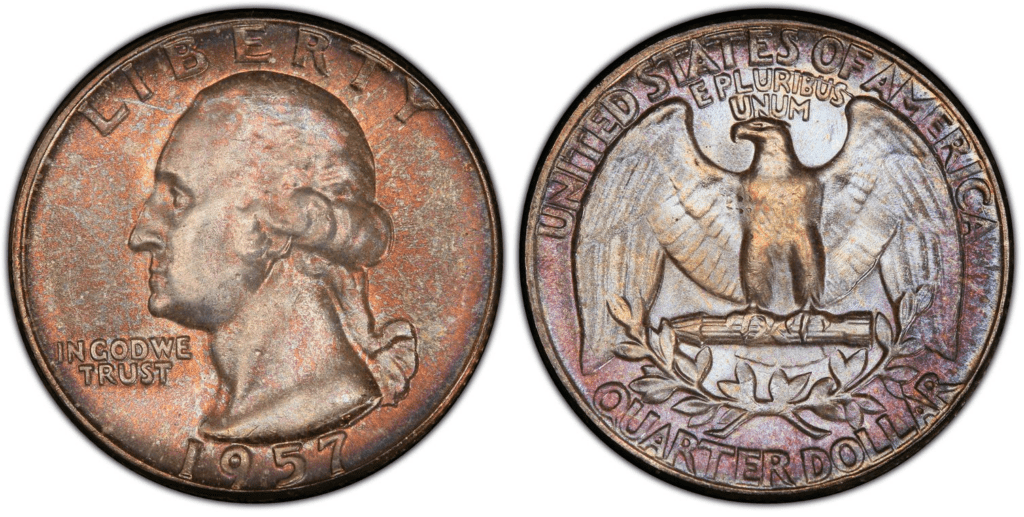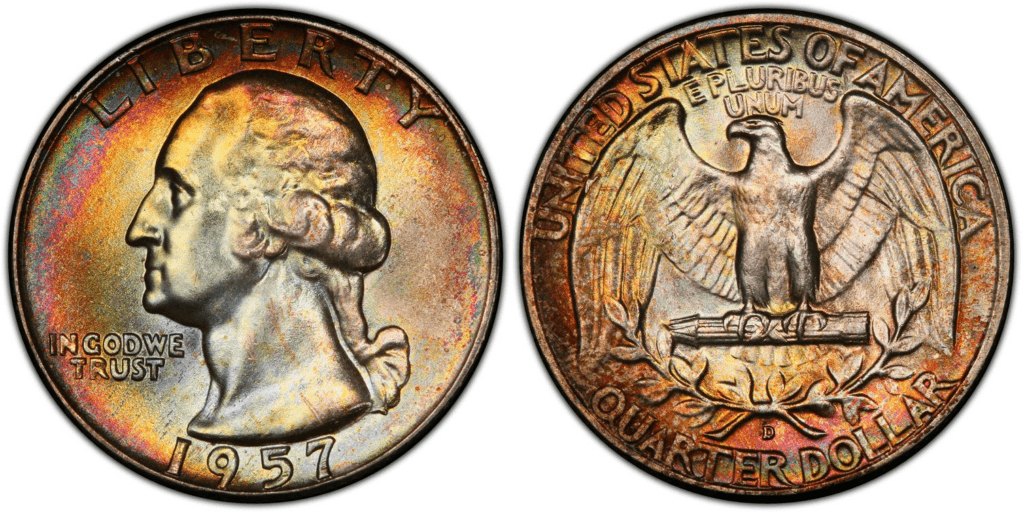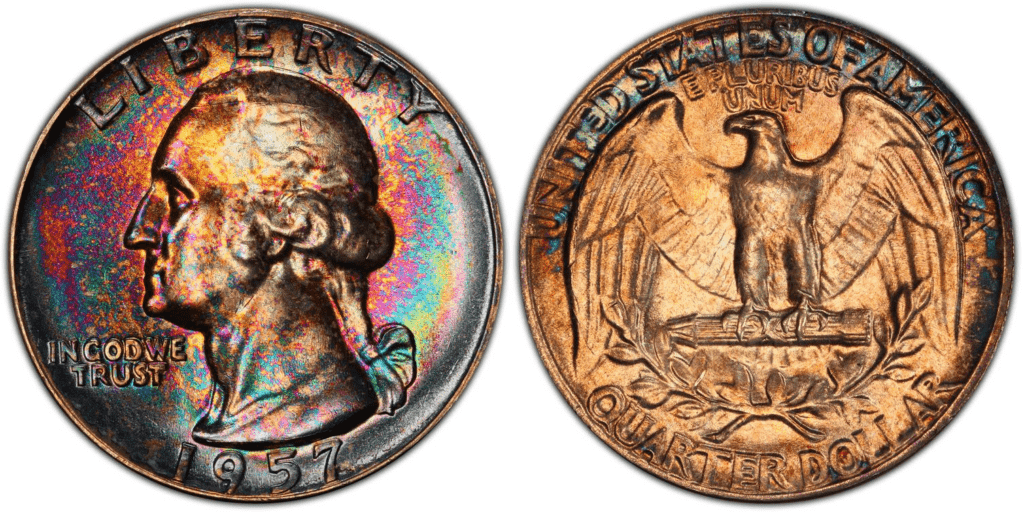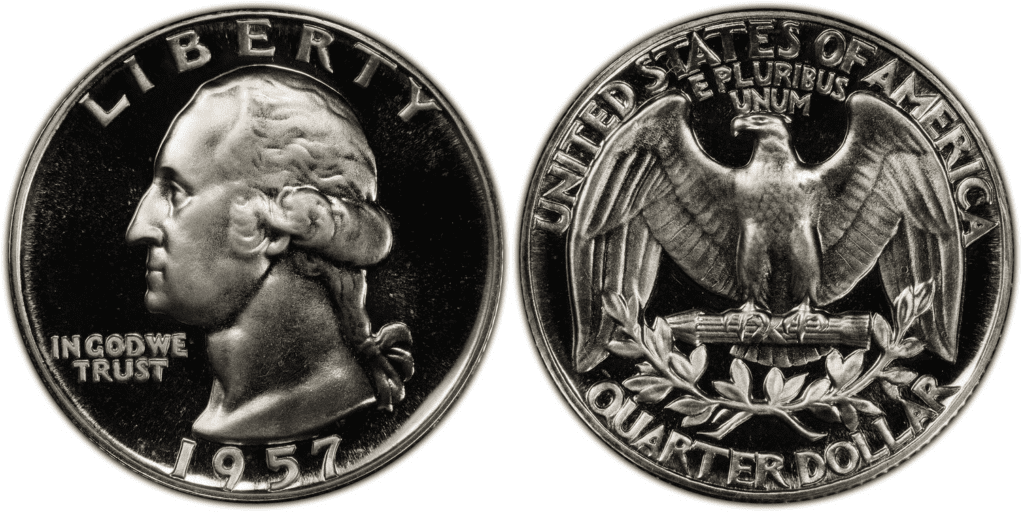What Is the 1957 Washington Quarter Made Of?
The 1957 Washington quarter has a face value of 25 cents, a mass of 6.25 grams, a diameter of 24.3 mm, and a reeded edge. When it comes to composition, it is made of 90% silver and 10% copper. All Washington quarters have silver content before 1965.
The Coinage Act of 1965 transitioned the US Mint from striking silver coins to base-metal coins. Thus, today, the Washington quarter is made of copper and nickel.

The Washington quarter was first issued in 1932 by the US Mint. The designer of the original version is the sculptor John Flanagan. In his design, the obverse shows George Washington facing to the left. On top of him is the word LIBERTY.
Just under his chin, you’ll read the US motto, “IN GOD WE TRUST.” Below the bust of Washington is the year of minting, 1957.
On the reverse, you’ll find the heraldic eagle with its wings outspread. In its talon, you’ll find a bundle of arrows. Below the arrow is an olive branch. Inscriptions include UNITED STATES OF AMERICA and QUARTER DOLLAR.
1957 Washington Quarter Varieties
In 1957, the US Mint produced 125,704,112 Washington quarters through its Philadelphia and Denver Mint Centers. The Denver Mint produced the most Washington quarters, while Philadelphia produced standard-struck and proof-struck coins.
For the 1957 Washington quarter, there were three varieties produced. These are the 1957 D, 1957 P with no mint mark, and the 1957 P proof Washington Quarter.
Aside from that, some coins with errors also created a new variety. Here are the 1957 Washington Quarter varieties that you should know.
1957 D Washington Quarter
Year of minting: 1957
Mint Mark: D
Place of minting: Denver
Quantity produced: 77,924,160
Face Value: $0.25 (twenty-five cent)
Price: $0.25 to $31 (or more)
Mass: 6.30 grams
Edge: Reeded
Designer: John Flanagan
Composition: 90% silver and 10% copper
Diameter: 24.3 millimeters
Thickness: 1.75 millimeters

photo source: PCGS
The 1957 D Washington quarter was struck in the Denver Mint. All 1957 quarters struck in Denver bear the D mint mark. The Denver Mint produced the most number of 1957 D quarters with a mintage of 77,924,160. This figure is significantly higher than the number of 1956 D quarter coins, which is just 32,334,500.
Because there are a lot of 1957 D quarters, you should easily find one in Gem condition. The price starts at around $0.25 to $31. It can be higher depending on the condition of the coin.
1957 P Washington Quarter
Year of minting: 1957
Mint Mark: No mint mark
Place of minting: Philadelphia
Quantity produced: 46,532,000
Face Value: $0.25 (twenty-five cent)
Price: $0.25 to $7 (or more)
Mass: 6.30 grams
Edge: Reeded
Designer: John Flanagan
Composition: 90% silver and 10% copper
Diameter: 24.3 millimeters
Thickness: 1.75 millimeters

photo source: PCGS
The 1957-P quarter coin was made in the Philadelphia Mint. At the end of 1957, 46,532,000 P Washington quarter coins were produced, far less than what the Denver Mint produced.
However, this is a higher mintage than many P Washington quarters produced in 1956 and 1958.
Now, here’s what’s interesting. The 1957-P quarter can easily be found in MS 66 and MS 67 grades. However, 1957-P with MS 69 is very rare. Only a few of them exist today. Not only that, but at the time of this writing, no 1957-P quarter was given a grade of MS 70.
The price of the 1957 quarter may range from $0.25 to $7, but it can be higher, especially when sold in the open market.
1957 P Proof Washington Quarter
Year of minting: 1957
Mint Mark: No mint mark
Place of minting: Philadelphia
Quantity produced: 1,247,952
Face Value: $0.25 (twenty-five cent)
Price: $8 to $14 (or more)
Mass: 6.30 grams
Edge: Reeded
Designer: John Flanagan
Composition: 90% silver and 10% copper
Diameter: 24.3 millimeters
Thickness: 1.75 millimeters

photo source: PCGS
In 1957, only about 1 million proof quarter coins were made by the Philadelphia mint. That’s okay since proof coins are meant for collectors and not for circulation. Moreover, the lower the mintage, the higher the coin’s value might become since there can be a higher demand.
In 1956, many people speculated that proof coins would dramatically increase in value in just a few years. As a result, many collectors ordered multiple proof sets of the 1957 proof quarter coins. Proof coins are more beautiful, detailed, and shinier. The average price may range from $8 to $14.
List of 1957 Washington Quarter Errors
As mentioned above, there were over 125 million 1957 Washington quarters in total. You can imagine how fast the Mint centers worked to get this number. With millions of coins, there are also millions of chances that an error coin would come about. It’s just a matter of time before an error coin is produced.
For the 1957 quarter, perhaps, the most sought-after coin error is the 1957 25C Type B Rev (Regular Strike). Here’s an example of this coin:

The 1957 25C Type B Rev is interesting because the obverse side is struck with a standard die, but the reverse was struck with a proof die. If you find something like this, you can sell it for a hundred to a thousand dollars.
Aside from that, there are common errors you will also see in other series of coins. For example, you’ll find 1957 quarters with a die break error. This happens when the die breaks, and its crack is engraved on the coin.
Another example is the repunched mintmark (RPM) error. The mint mark is supposed to be struck once on the coin. However, in RPM error, the mint mark was hit twice, leaving the mint mark on the coin to look doubled. A rarer variety of this coin is when the mint mark was struck thrice.
How Much Is The 1957 Washington Quarter Worth Today?
As its face value suggests, the 1957 Washington quarter is worth $0.25. The melt value is higher since it is made of silver. The Melt value is $4.3295.
While you may think that the 1957 quarter isn’t that valuable, you should think again. 1957 quarter coins are astronomically more valuable than their face value or melt value.
Here’s a 1957 Washington Quarter values chart to help you get an overview of its price:
| Coin | Condition | Grade | Mintage | Value |
| 1957 D Washington Quarter | Circulated/mint | Not graded | 77,924,160 | $0.25 to $31 |
| 1957 D Washington Quarter | Uncirculated/mint | MS-66 | 77,924,160 | $38 to $288 |
| 1957 D Washington Quarter | Uncirculated/mint | MS-67 | 77,924,160 | $120 to $2,400 |
| 1957 D Washington Quarter | Uncirculated/mint | MS-68 | 77,924,160 | $1,528 to $11,400 |
| 1957 P Washington Quarter | Circulated/mint | Not graded | 46,532,000 | $0.25 to $7 |
| 1957 P Washington Quarter | Uncirculated/mint | MS-66 | 46,532,000 | $20 to $50 |
| 1957 P Washington Quarter | Uncirculated/mint | MS-67 | 46,532,000 | $57 to $160 |
| 1957 P Washington Quarter | Uncirculated/mint | MS-68 | 46,532,000 | $1,080 to $1,920 |
| 1957 P Proof Washington Quarter | Uncirculated/mint | Not graded | 1,247,952 | $8 to $14 |
| 1957 P Proof Washington Quarter | Uncirculated/mint | MS-67 | 1,247,952 | $98 to $210 |
| 1957 P Proof Washington Quarter | Uncirculated/mint | MS-68 | 1,247,952 | $132 to $329 |
| 1957 P Proof Washington Quarter | Uncirculated/mint | MS-69 | 1,247,952 | $2,703 to $2,880 |
As you can see from the table, the 1957 quarters have a fair share of their expensive coins. If you’re still not convinced that this coin can be worth a fortune, look at its auction records.
For example, the auction record for a 1957-D 25C (Regular Strike) with an MS68 grade is $11,400. A 1957 25C (Regular Strike) auction record for an MS68 grade is $3,819. Finally, for the 1957 25C, DCAM (Proof) with a grade of PR69, the auction record is $3,800.
How Does The Grading System Work?
The Sheldon Scale is used by numismatists to provide a numerical value to coins. The Sheldon Scale goes from poor (P-1) to perfect mint state (P-1) (MS-70). Coins were originally evaluated using words to reflect their condition (Good, Fair, Excellent, Etc.). Unfortunately, coin collectors and dealers had different ideas about what each of these terms represent.
Professional numismatists joined together in the 1970s and established CoinGrading standards. These numismatists now assign grades at key places on the seventy-point scale, using the most regularly utilized numeric points in conjunction with the original adjective grade. The following are the most common coin grades:
-
-
- (P-1) Poor – Indistinguishable and probably damaged; if used, must have a date and mintmark; otherwise, rather battered.
- (FR-2) Fair – Nearly smooth, but without the damage that a coin graded Poor often possesses. The coin must have enough detail to be identified.
- (G-4) Fair – Inscriptions have merged into the rims in some areas, and important elements have been mostly erased.
- (VG-8) Very Good- A little weathered, but all of the primary design elements are visible, albeit faintly. There is little if any, central detail left.
- (F-12) Good – The item is very worn, yet the wear is even, and the overall design details stand out clearly. Rims are almost completely isolated from the field.
- (VF-20) Very Fine – Moderately weathered, with some finer features still visible. The motto or all letters of LIBERTY are readable. Both sides of the coin have entire rims that are separated from the field.
- (EF-40) Extremely Fine – Gently used; all gadgets are visible, and the most important ones are bold. The finer details are bold and clear, however, light wear may be seen.
- (AU-50) Uncirculated – Slight evidence of wear on the coin’s design’s high points; may have contact marks; eye appeal should be adequate.
- (AU-58) Uncirculated Choice – Slight traces of wear, no severe contact marks, almost full mint shine, and great eye appeal.
- (MS-60) Mint State Basal – Strictly uncirculated; no indication of wear on the coin’s highest points, but an unsightly coin with reduced luster, visible contact marks, hairlines, and other flaws.
- (MS-63) Mint State Acceptable – Uncirculated, but with contact scratches and nicks, little reduced shine, but otherwise appealing appearance. The strike is weak to average.
- (MS-65) Mint State Choice – Uncirculated with great mint shine, very little contact blemishes, and exceptional eye appeal. The strike is unusually severe.
- (MS-68) Mint State Premium Quality – Uncirculated with superb luster, no obvious contact marks to the naked eye, and exceptional eye appeal. The strike is quick and appealing.
- (MS-69) Almost Perfect Mint State – Uncirculated with perfect brilliance, a sharp and appealing strike, and extremely good eye appeal. A near-perfect coin with minor imperfections in the planchet, strike, and contact markings (seen only under 8x magnification).
- (MS-70) Mint State Perfect – Under 8x magnification, there are no tiny imperfections discernible; the strike is crisp, and the coin is perfectly centered on a beautiful planchet. Rarely seen on a coin, this coin is bright and whole, with original luster and exceptional eye appeal.
-
Where To Buy Or Sell 1957 Washington Quarter?
There are different places where you can buy or sell 1957 Washington quarters. One of the quickest and easiest ways to buy or sell coins is online. Here are some of the websites or online vendors you can try:
- Amazon
- Etsy
- eBay
- USA Coin Book
- JM Bullion
- Coin Trackers
Aside from the Internet, you can also visit the following places near you:
- Coin shops
- Pawnshops
- Antique stores
- Auction houses
You can also get in touch with fellow coin collectors. If possible, join coin clubs and groups to find people who might be interested in buying your coins or selling their coins to you.
FAQs
What 1957 quarters have errors that are worth money?
The 1957 25C Type B Rev is an error coin that could be worth hundreds of dollars. Aside from that, coins with doubled-die errors can also be worth a lot of money, especially when the error is more prominent.
Where is the mintmark on the 1957 Washington quarter?
The mintmark on the 1957 Washington quarter is found on the reverse side of the coin. It can easily be found on top of the second “R” of the word quarter or just below the center of the olive branch.
Is there a 1957 quarter with no mint mark?
1957 quarters struck in Philadelphia don’t have a mint mark. However, 1957 quarters struck in Denver have a D mintmark.
What makes a 1957 quarter valuable?
The 1957 quarter becomes valuable when it has excellent preservation and is still in good condition. Moreover, when a quarter is graded, it establishes its actual value. A rare 1957 quarter can be easily sold for hundreds and thousands of dollars.



